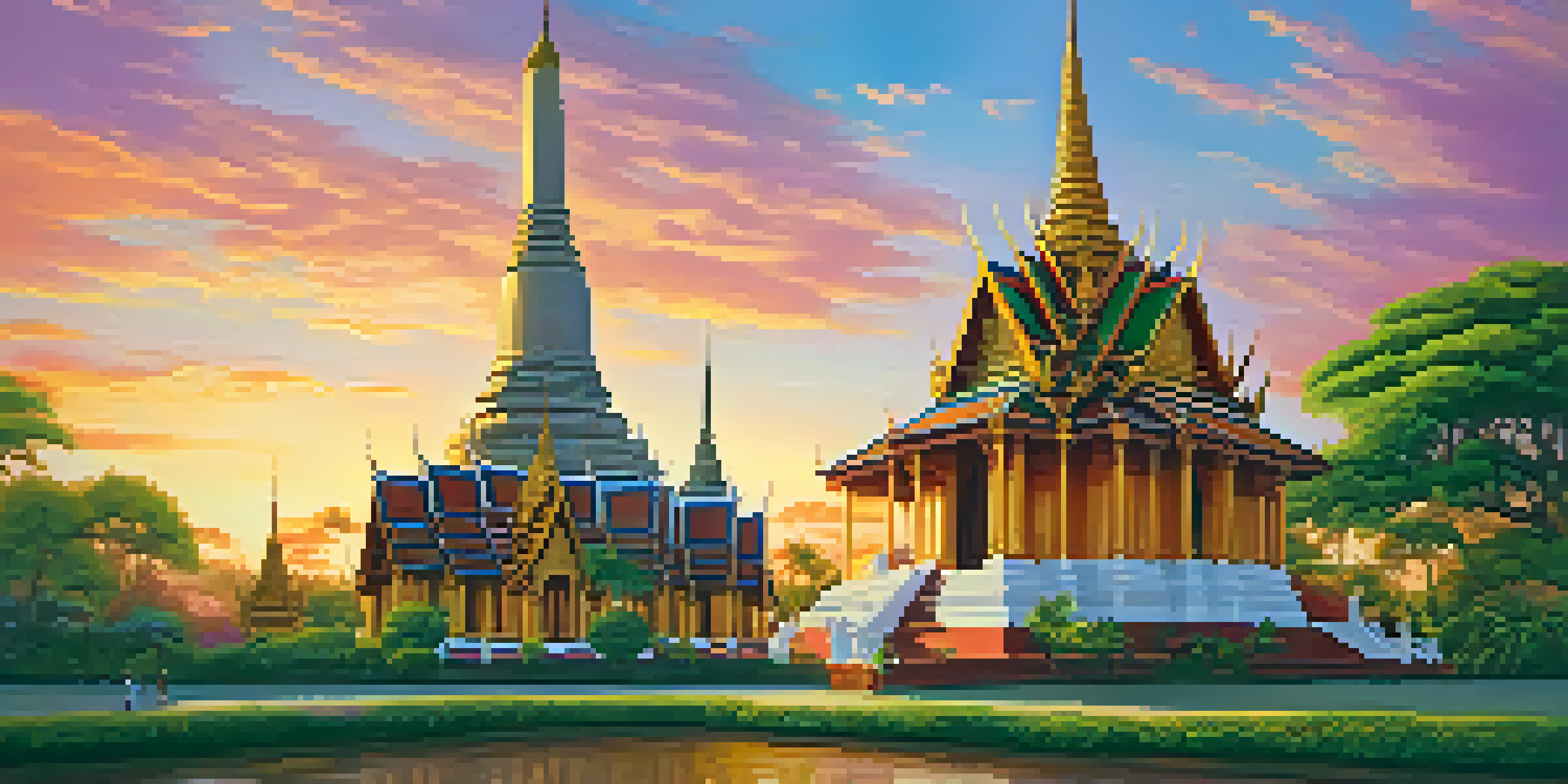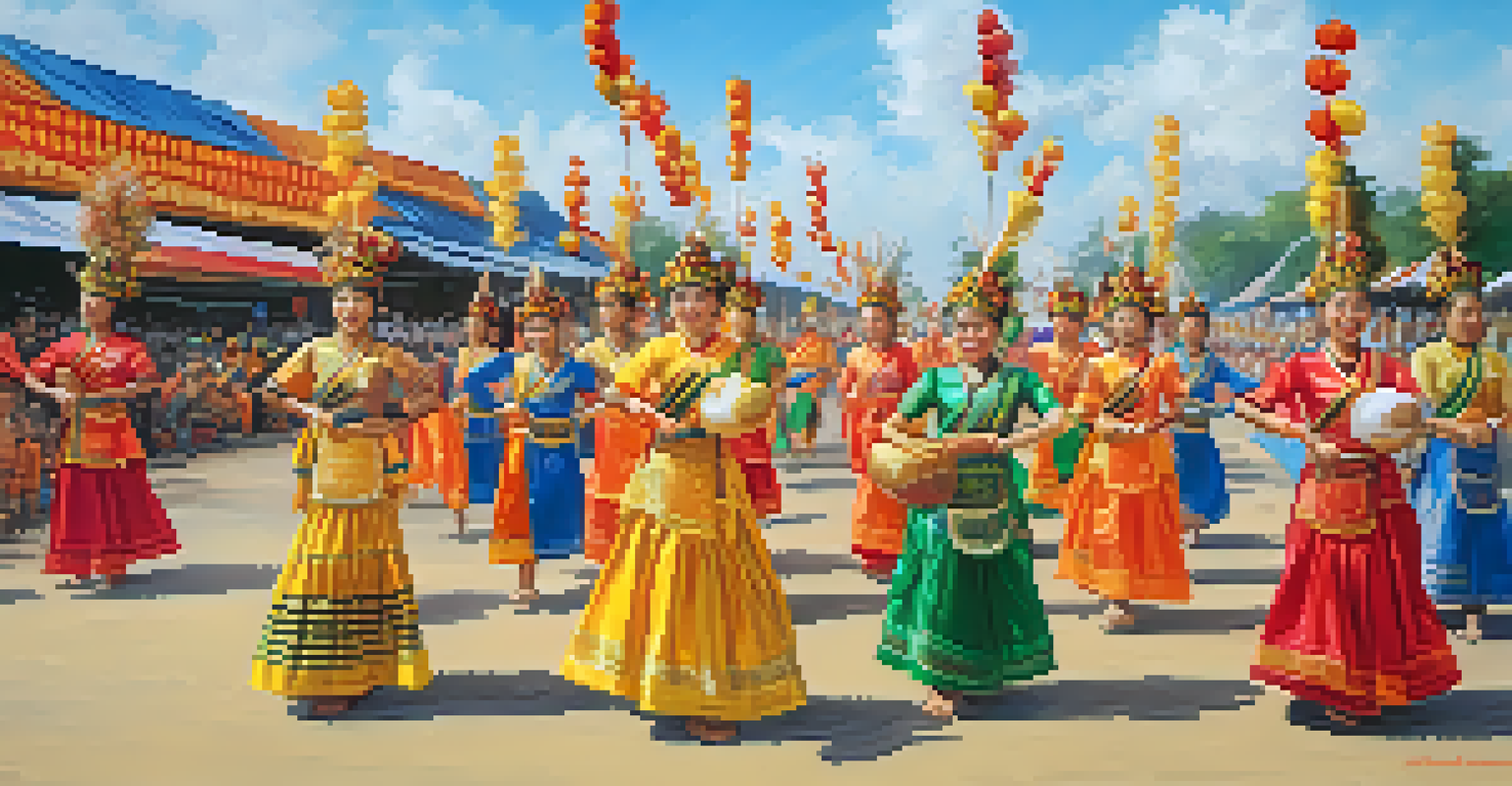Understanding Traditional Thai Art Styles Across Different Regions

Introduction to Traditional Thai Art: An Overview
Traditional Thai art is a vibrant expression of the country's culture and history, encompassing various forms such as painting, sculpture, and architecture. Each region of Thailand has its own unique artistic style, influenced by local customs, beliefs, and resources. Understanding these variations helps us appreciate the depth and richness of Thai heritage.
Art is the most beautiful of all lies.
For example, the intricate designs found in temple murals often depict Buddhist themes and stories, showcasing not only artistic skill but also spiritual significance. This fusion of art and religion is a hallmark of Thai culture, making it essential to grasp the context behind these creations. As we delve into the regional differences, we uncover the stories that shape these artistic traditions.
Ultimately, exploring traditional Thai art is like embarking on a journey through time, revealing how geography, history, and spirituality intertwine. Each piece of art serves as a window into the soul of its region, inviting us to explore the diverse narratives that define Thai artistry.
Central Thailand: The Heart of Thai Art
Central Thailand is often considered the cradle of Thai art, with Bangkok as its bustling capital. This region is renowned for its ornate temples, such as Wat Phra Kaew, which showcases the intricate craftsmanship typical of Central Thai design. The use of gold leaf, vivid colors, and complex patterns creates a visual feast that attracts both locals and tourists alike.

Moreover, Central Thailand has a rich tradition of mural painting, where artists depict historical events and religious narratives on temple walls. These murals not only serve an aesthetic purpose but also educate viewers about Buddhist teachings and Thai folklore. The blending of art and education in this region exemplifies the importance of storytelling in Thai culture.
Thai Art Reflects Cultural Diversity
Each region of Thailand showcases its unique artistic style shaped by local customs, beliefs, and resources.
As we explore Central Thailand, we see how art is not just about beauty but also about conveying messages and preserving history. The stunning visuals and deep meanings found in this region's art reflect a society that values both creativity and spirituality, making it a true cornerstone of traditional Thai art.
Northern Thailand: A Unique Cultural Identity
Northern Thailand boasts a distinct artistic style influenced by its history and ethnic diversity. The Lanna culture, which flourished in this region, is famous for its intricate wood carvings and textiles. Traditional crafts such as silk weaving showcase the skill and creativity of local artisans, often featuring unique patterns and vibrant colors that tell stories of the land and its people.
Every artist dips his brush in his own soul, and paints his own nature into his pictures.
In addition to crafts, Northern Thai temples, or 'wats,' often feature elaborate decorations, including the towering 'chedis' or stupas. These structures are adorned with intricate motifs and murals, reflecting the region's Buddhist heritage. The artistic expressions found in Northern Thailand are not only visually stunning but also deeply connected to the local way of life.
By understanding the art of Northern Thailand, we appreciate the region's commitment to preserving its cultural identity amidst modernization. The blend of traditional craftsmanship and contemporary influences creates a dynamic art scene that continues to thrive and evolve, making it a vital part of Thailand's artistic landscape.
Northeastern Thailand: The Isan Art Scene
Isan, or Northeastern Thailand, is known for its vibrant folk art, which reflects the region's rural lifestyle and agricultural heritage. The art often incorporates natural materials, such as bamboo and clay, showcasing the resourcefulness of local artisans. Traditional Isan crafts, such as basket weaving and pottery, are not only functional but also serve as expressions of cultural identity.
The region's festivals, like the famous Bun Bang Fai (Rocket Festival), provide a backdrop for colorful art forms, including traditional music and dance. These events celebrate the agricultural cycle and are filled with artistic performances that highlight the rich cultural tapestry of Isan. The lively atmosphere and communal spirit during these celebrations inspire a unique artistic expression that is deeply rooted in local traditions.
Religion Shapes Thai Artistic Expression
Buddhism significantly influences traditional Thai art, integrating spiritual themes into various forms like murals and sculptures.
In exploring the art of Northeastern Thailand, we find a refreshing perspective that honors simplicity and community. The vibrant colors and lively forms reflect a strong connection to nature and a celebration of everyday life, making Isan art a vital part of Thailand's diverse artistic narrative.
Southern Thailand: Coastal Inspirations
Southern Thailand, with its picturesque beaches and islands, has a unique artistic style that draws inspiration from its coastal environment. The region is known for its intricate batik textiles, often featuring oceanic motifs and vibrant colors that reflect the natural beauty surrounding it. Artisans skillfully use wax-resist dyeing techniques to create stunning patterns that are both beautiful and functional.
In addition to textiles, Southern Thailand is home to traditional wooden boat-making, a craft passed down through generations. These boats are not only essential for fishing and transportation but are also works of art, showcasing the skill and craftsmanship of local builders. The designs often incorporate symbolic elements that reflect the cultural beliefs and stories of the coastal communities.
As we delve into Southern Thai art, we discover a harmonious blend of nature and creativity. The coastal environment shapes artistic expressions that celebrate the region's rich maritime culture, making it a vital part of Thailand's artistic heritage.
The Influence of Religion in Thai Art
Religion plays a significant role in shaping traditional Thai art, particularly Buddhism, which is deeply embedded in the country's culture. Many art forms, such as mural painting and sculpture, are directly influenced by Buddhist teachings and iconography. Temples serve as living galleries, showcasing intricate artwork that conveys spiritual messages and illustrates the life of the Buddha.
For instance, the iconic 'Phra Buddha' statues found in various regions are not only artistic representations but also serve as focal points for devotion and worship. These statues often embody specific attributes, such as serenity or strength, inspiring both artists and worshippers alike. The connection between art and spirituality in Thailand is a testament to the profound impact of religion on the nation's cultural landscape.
Modern Takes on Traditional Art
Contemporary artists are blending traditional Thai art with modern techniques, creating innovative pieces that resonate with today's audience.
By exploring the interplay between religion and art, we gain insight into the values and beliefs that shape Thai society. The rich tapestry of religious motifs and narratives found in traditional art serves as a reminder of the enduring influence of spirituality in everyday life, making it an essential aspect of understanding Thai culture.
Modern Interpretations of Traditional Thai Art
In recent years, there has been a resurgence of interest in traditional Thai art, leading to modern interpretations that blend old and new techniques. Contemporary artists are experimenting with traditional forms, incorporating modern themes and materials to create unique pieces that resonate with today's audience. This fusion of styles reflects a dynamic cultural landscape that honors the past while embracing innovation.
For example, some artists are using digital media to reinterpret classic Thai motifs, creating vibrant visual experiences that reach a broader audience. Galleries and exhibitions across the country showcase these works, encouraging dialogue between traditional and contemporary art forms. This evolution highlights the adaptability of Thai art, demonstrating its relevance in a rapidly changing world.

By examining modern interpretations of traditional Thai art, we see how creativity continues to thrive while rooted in cultural heritage. This ongoing dialogue between past and present enriches the artistic landscape, ensuring that Thai art remains a vital and evolving part of the country's identity.
Conclusion: Celebrating the Diversity of Thai Art
As we conclude our exploration of traditional Thai art, it's clear that each region contributes its unique flavor to the rich tapestry of artistic expression. From the ornate temples of Central Thailand to the vibrant folk art of Isan, every style tells a story that reflects the culture and history of its people. This diversity not only enriches the artistic landscape but also fosters a deeper understanding of Thailand as a whole.
Moreover, the interplay between religion, nature, and community in Thai art highlights the interconnectedness of these elements in shaping cultural identity. As we celebrate the beauty and complexity of traditional Thai art, we also honor the artisans and communities that keep these traditions alive for future generations. Their dedication ensures that these cultural treasures continue to inspire and educate.
In recognizing the significance of traditional Thai art, we embrace a broader appreciation for the diverse narratives that define this remarkable country. Each artwork serves as a bridge connecting us to the past while inviting us to engage with the present, ensuring that the spirit of Thai artistry lives on.